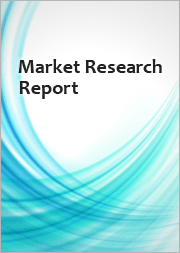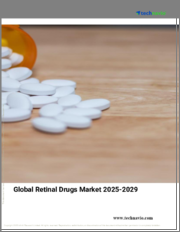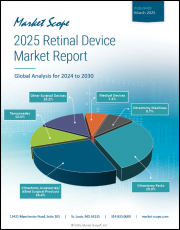
|
시장보고서
상품코드
1702495
인도의 안과용 의약품 시장 : 약물 종류별, 제품 유형별, 적응 질환별, 유통 채널별, 지역별, 기회 및 예측(2019-2033년)India Ophthalmic Drugs Market Assessment, By Drug Class, By Product Type, By Disease Indication, By Distribution Channel, By Region, Opportunities and Forecast, FY2019-FY2033F |
||||||
인도의 안과용 의약품 시장 규모는 2026-2033년 예측 기간 동안 7.62%의 CAGR로 2025년 3억 820만 달러에서 2033년 5억 5,460만 달러로 확대될 것으로 예상됩니다. 이 나라에서 시장의 급격한 확대는 눈 관련 질환의 유병률 증가, 고령화 인구의 급속한 증가, 주요 제약사의 강력한 존재감, 생활습관 관련 문제의 유병률 증가 등에 기인합니다. 유엔인구기금(UNFPA)의 추정에 따르면, 인도의 노인 인구 비율은 2050년까지 20%에 달할 것으로 예상됩니다.
또한, 안과용 의약품의 효능을 향상시키기 위한 약물 제형 및 전달 시스템의 급속한 발전은 시장에 유리한 성장 기회를 제공할 것으로 예상됩니다. 서방형 제제 및 무방부제 옵션과 같은 치료 기술이 보급되면서 치료 결과와 환자 순응도가 향상되고 있습니다. 또한, 바이오시밀러와 생물학적 제제의 출현은 환자 집단의 다양한 요구에 부응하기 위해 사용 가능한 치료법의 폭을 넓히고 있습니다.
인도의 안과용 의약품 시장에 대해 조사했으며, 시장 개요와 함께 약제 종류별, 제품 유형별, 적응증별, 유통 채널별, 지역별 동향, 시장 진출 기업 프로파일 등의 정보를 전해드립니다.
목차
제1장 프로젝트 범위와 정의
제2장 조사 방법
제3장 주요 요약
제4장 인도의 안과용 의약품 시장 전망, 2019-2033년
- 시장 규모 분석과 예측
- 시장 점유율 분석과 예측
- 2025년 시장 맵 분석
- 약물 종류별
- 제품 유형별
- 적응 질환별
- 유통 채널별
- 지역별
제5장 수요 공급 분석
제6장 밸류체인 분석
제7장 Porter's Five Forces 분석
제8장 PESTLE 분석
제9장 가격 분석
제10장 시장 역학
- 시장 촉진요인
- 시장 과제
제11장 소비자 구매 행동 분석
제12장 시장 동향과 발전
제13장 규제 상황
제14장 임상시험 개요
제15장 사례 연구
제16장 경쟁 구도
- 시장 리더 탑 5 경쟁 매트릭스
- 진출 기업 탑 5 SWOT 분석
- 시장의 주요 기업 탑 10 상황
- Alcon Laboratories, Inc.
- Novartis AG
- Regeneron Pharmaceuticals, Inc.
- Bausch Health Companies, Inc.
- AbbVie, Inc.
- Pfizer, Inc.
- Coherus BioSciences, Inc.
- Merck & Co., Inc.
- Bayer AG
- Santen Pharmaceutical Co., Ltd.
제17장 전략적 제안
제18장 조사 회사 소개 및 면책사항
ksm 25.04.22India ophthalmic drugs market is projected to witness a CAGR of 7.62% during the forecast period FY2026-FY2033, growing from USD 308.20 million in FY2025 to USD 554.60 million in FY2033. The rapid expansion of the market in the country can be attributed to the rising prevalence of eye-related disorders, the rapid expansion of the aging population, the strong presence of leading pharmaceutical companies, and the increasing prevalence of lifestyle-related issues. According to the estimates of the United Nations Population Fund (UNFPA), the percentage of the elderly population in India is expected to reach 20% by 2050.
Additionally, rapid advancements in drug formulations and delivery systems to enhance the efficacy of ophthalmic medications are also expected to provide lucrative growth opportunities for the market. Technologies including sustained-release formulations and preservative-free options are gaining traction, improving treatment outcomes and patient compliance. Moreover, the emergence of biosimilars and biologics is also expanding the range of available therapies, catering to the diverse requirements of the patient population.
Increasing Healthcare Expenditure Supports Market Expansion
Rising health expenditure is one of the major drivers of the market. The increasing emphasis on ensuring the availability of high-quality healthcare services and products in the country is propelling the requirement for various eye care treatments. For instance, in BE 2023-24, the health expenditure in India increased to approximately USD 70.2 billion (INR 5.85 lakh crores). The government's focus on enhancing healthcare delivery is resulting in the establishment of specialized eye care centers and programs, which directly support the demand for ophthalmic drugs. Moreover, this increase in expenditure is facilitating advancements in drug research and development, allowing manufacturers to introduce innovative treatments for prevalent conditions such as glaucoma, diabetic retinopathy, and age-related macular degeneration. Additionally, the rise in healthcare spending has also enabled the adoption of advanced drug delivery systems, including preservative-free formulations and sustained-release therapies, improving patient compliance and treatment outcomes. Thus, many pharmaceutical companies are leveraging these opportunities to address the unmet requirements of the market.
Rising Cases of Eye Diseases Boost Market Demand
Conditions such as glaucoma, diabetic retinopathy, macular degeneration, and cataracts are becoming more common in India due to aging demographics, lifestyle changes, and rising incidences of diabetes and hypertension. According to the estimates of an article published in the Indian Journal of Ophthalmology in October 2023, age-related macular degeneration affects approximately 1.4-3.1% of the Indian population. This growing burden of eye-related disorders has thus created a substantial demand for effective pharmaceutical treatments. An increasing number of awareness campaigns about eye health, along with government initiatives aimed at improving access to ophthalmic care, are encouraging patients to seek timely treatment, further bolstering the market's expansion. Additionally, India's large patient pool and its well-established clinical research infrastructure also attract pharmaceutical companies to invest in ophthalmic drug development.
Anti-VEGF Agents Account for Significant Share of the Market
Anti-VEGF agents hold a significant share of the India ophthalmic drugs market due to their effectiveness in treating critical retinal disorders such as diabetic retinopathy, age-related macular degeneration, and retinal vein occlusion, among others. According to an article published in Springer Nature in January 2024, the prevalence of diabetic retinopathy in India is 12.5%. Anti-VEGF therapies target vascular endothelial growth factor, the protein responsible for abnormal blood vessel formation, which can result in loss of vision. By inhibiting VEGF activity, these agents slow disease progression and improve visual outcomes, thus supporting the segment's expansion. These agents are also becoming increasingly popular in the country as they deliver superior anatomical and visual results compared to traditional treatments like laser photocoagulation.
Eye Drops Hold Major Market Share
The dominance of the segment can be attributed to the ease of use associated with eye drops and their ability to address a wide range of ophthalmic diseases, including allergies, glaucoma, and dry eye syndrome, among others. Moreover, the prolonged utilization of digital devices in the country is also driving the demand for eye drops. Additionally, both prescription and over-the-counter (OTC) eye drops cater to diverse patient requirements, further expanding their market share. Additionally, their affordability and easy accessibility through retail pharmacies make them a preferred choice for a larger population base for addressing both minor irritations and chronic conditions. As demand for efficient and user-friendly ophthalmic solutions continues to grow, eye drops are expected to maintain their dominant position in the India ophthalmic drugs market.
Future Market Scenario (FY2026 - FY2033F)
Rapid population growth, expansion of the geriatric population, and increasing awareness about various ophthalmic diseases and disorders and the different treatment options available in the country are expected to provide lucrative growth opportunities for the market. Additionally, increasing government efforts to improve healthcare infrastructure will further support the market's expansion.
Meanwhile, investments in research and development by pharmaceutical companies based in India will support the introduction of innovative treatment solutions, contributing to the sustained growth of the market. Pharmaceutical companies are also focusing on partnering with global players to enhance the affordability and accessibility of ophthalmic drugs in India.
Key Players Landscape and Outlook
The growing collaborations among leading players in the industry to distribute ophthalmic drugs in the country are supporting the market's expansion. For instance, in March 2025, Cipla Limited and Formosa Pharmaceuticals, Inc. entered in an exclusive pact for the commercialization of clobetasol propionate ophthalmic suspension, 0.05% (APP13007), an innovative treatment for pain and post-operative inflammation following ocular surgery across countries including India, Bangladesh, Malaysia, Nigeria, Argentina, South Africa, Nepal, Colombia, Sri Lanka, Myanmar, and Kenya. This new steroid represents a significant advancement in the ophthalmic industry, providing notable patient benefits, thus providing lucrative growth opportunities for the market.
Additionally, in March 2024, Roche Products (India) Pvt. Ltd. launched Vabysmo (faricimab) for treating diabetic macular edema and neovascular or wet age-related macular degeneration. Vabysmo is transforming the existing standard of care for these diseases. The existing treatment options include frequent physician visits and eye injections. Vabysmo reduces the requirement of eye injections to once in four months, while achieving similar anatomical improvements and vision gains.
Table of Contents
1. Project Scope and Definitions
2. Research Methodology
3. Executive Summary
4. India Ophthalmic Drugs Market Outlook, FY2019-FY2033F
- 4.1. Market Size Analysis & Forecast
- 4.1.1. By Value
- 4.2. Market Share Analysis & Forecast
- 4.2.1. By Drug Class
- 4.2.1.1. Anti-allergy
- 4.2.1.2. Anti-inflammatory
- 4.2.1.2.1. Non-steroidal drugs
- 4.2.1.2.2. Steroids
- 4.2.1.3. Anti-VEGF Agents
- 4.2.1.4. Anti-glaucoma
- 4.2.1.5. Others
- 4.2.2. By Product Type
- 4.2.2.1. Gels
- 4.2.2.2. Eye Solutions and Suspensions
- 4.2.2.3. Capsules and Tablets
- 4.2.2.4. Eye Drops
- 4.2.2.5. Ointment
- 4.2.3. By Disease Indication
- 4.2.3.1. Dry Eyes
- 4.2.3.2. Allergies
- 4.2.3.3. Glaucoma
- 4.2.3.4. Infection
- 4.2.3.5. Retinal Disorders
- 4.2.3.6. Others
- 4.2.4. By Distribution Channel
- 4.2.4.1. Hospital Pharmacies
- 4.2.4.2. Retails Pharmacies
- 4.2.4.3. Online Pharmacies
- 4.2.5. By Region
- 4.2.5.1. North
- 4.2.5.2. East
- 4.2.5.3. West and Central
- 4.2.5.4. South
- 4.2.6. By Company Market Share Analysis (Top 5 Companies and Others - By Value, FY2025)
- 4.2.1. By Drug Class
- 4.3. Market Map Analysis, FY2025
- 4.3.1. By Drug Class
- 4.3.2. By Product Type
- 4.3.3. By Disease Indication
- 4.3.4. By Distribution Channel
- 4.3.5. By Region
5. Demand Supply Analysis
6. Value Chain Analysis
7. Porter's Five Forces Analysis
8. PESTLE Analysis
9. Pricing Analysis
10. Market Dynamics
- 10.1. Market Drivers
- 10.2. Market Challenges
11. Consumer Buying Behavior Analysis
12. Market Trends and Developments
13. Regulatory Landscape
14. Clinical Trials Overview
15. Case Studies
16. Competitive Landscape
- 16.1. Competition Matrix of Top 5 Market Leaders
- 16.2. SWOT Analysis for Top 5 Players
- 16.3. Key Players Landscape for Top 10 Market Players
- 16.3.1. Alcon Laboratories, Inc.
- 16.3.1.1. Company Details
- 16.3.1.2. Key Management Personnel
- 16.3.1.3. Products and Services
- 16.3.1.4. Financials (As Reported)
- 16.3.1.5. Key Market Focus and Geographical Presence
- 16.3.1.6. Recent Developments/Collaborations/Partnerships/Mergers and Acquisition
- 16.3.2. Novartis AG
- 16.3.3. Regeneron Pharmaceuticals, Inc.
- 16.3.4. Bausch Health Companies, Inc.
- 16.3.5. AbbVie, Inc.
- 16.3.6. Pfizer, Inc.
- 16.3.7. Coherus BioSciences, Inc.
- 16.3.8. Merck & Co., Inc.
- 16.3.9. Bayer AG
- 16.3.10. Santen Pharmaceutical Co., Ltd.
- 16.3.1. Alcon Laboratories, Inc.
Companies mentioned above DO NOT hold any order as per market share and can be changed as per information available during research work.



















